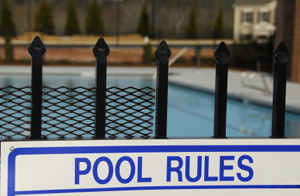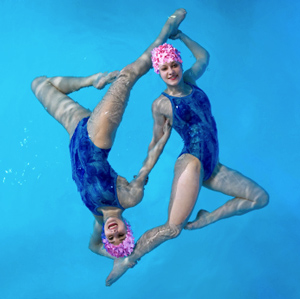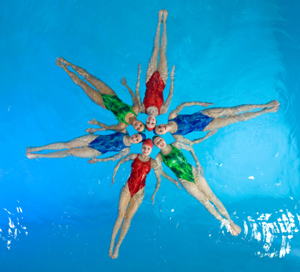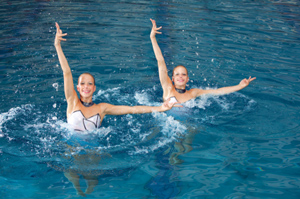Synchronized Swimming Rules & Regulations
 FINA, which stands for Fédération Internationale de Natation, writes the international rules and regulations for synchronized swimming. Most nations model their own synchro rules after FINA’s, but there are slight differences from country to country. The rules outlined below are based on those found in the 2009-2013 FINA Handbook.
FINA, which stands for Fédération Internationale de Natation, writes the international rules and regulations for synchronized swimming. Most nations model their own synchro rules after FINA’s, but there are slight differences from country to country. The rules outlined below are based on those found in the 2009-2013 FINA Handbook.
Gender Rules
Synchronized swimming, based on the huge majority alone, is mostly a woman’s sport. Men are not allowed to compete in the Olympics, World Championships, or any other FINA sanctioned events. However, many countries do allow men to participate in their national or local competitions. There are also a variety of international events, such as Opens, that permit male synchronized swimmers to compete alongside and against women.
Events

There are many different events in synchro: solo, duet, trio, team, figures, and combination—plus a few new experimental events that only exist at the FINA Trophy Cup, like thematic routines and the synchro highlight routine. Both technical and free programs for solos, duets and teams are required for each event athletes enter when competing above the junior level.
The exact structure of a synchronized swimming meet depends on the level of competition and the governing body under which the meet is run. So time limits and routine types can vary greatly from one to the next. The larger or more globally inclusive the meet is, the more standard the rules. Also, not all events are held at every competition.
Technical and Free Routines
Technical routines are shorter than free routines and contain required technical elements that must be performed in a specific order. Choreography between the elements must be the same for all the swimmers. The one exception to the required uniformity is pattern changes. Free routines are always little longer than their technical counterparts and all of the choreography is left entirely up to choice.
Solo, Duet, Trio and Team Events
Solo is an event in which only one swimmer performs. What’s synchronized about that? It’s a lot like watching a figure skater. Soloists swim “synchronize” with the music instead of their teammates.
In the duet and trio events, the focus of the synchronization is clearly between the swimmers. Two teammates perform together for a duet, three for a trio, four to eight for a team competition.
Figures
Figures is a unique, music-less event that takes the place of technical routines for athletes competing at or below the junior level. Each athlete, anonymously clad in a black suit and white cap, individually performs a series of compulsories for panels of judges. That score is then added to their routine score to make the composite score for rankings in each routine event.
Combination Routine

The combination routine, “combo” for short, is a hybrid event. Ten swimmers participate in the routine, but in different combinations of groups throughout the performance. Sometimes all ten athletes swim, sometimes just one, and the particular groupings can change at any time during the routine. Swimmers not involved in a particular part of the routine eggbeater along the side and are not allowed to touch the side or bottom of the pool.
Competitions
Olympic Games & World Championships
The rules for both of these competitions are the same, except for the number of events each meet allows. Duet and team are the only two events allowed in the Olympics; the World Championships include solo, duet, team and combination. In either competition, both technical and free routines are required with the exception of the combination routine.
Junior Meets
At the junior level, athletes swim only free routines and perform figures instead of technical routines. The events in junior meets include solo, duet, (trio in some countries,) team and combo routines. All the competitors must do figures.
Novice, Intermediate, & Age Group
These three levels of synchro swimmers also do figures instead of technical routines. There are no limits on choreography in the free solo, duet, trio, or team routines, thought there are some required elements. The degree of difficulty of the figures and of the required elements in the routines increases from novice to intermediate to age group.
Scoring and Judging
Scores are given by the judges are on a scale from 0 to 10, in tenth-of-a-point increments. 10 is the perfect score.
In the figures event, judges evaluate design and control. The design of a figure is determined by the accuracy of the positions and the correctness of the transitions between those positions. Control includes extension, height, stability, and an even tempo.

Routine judges are always evenly divided into two categories. For free routines, half of them judge artistic impression and the other half judge technical merit. For technical routines, judges evaluate the performance based on execution and overall impression.
Artistic impression judges consider choreography, interpretation of music, and manner of presentation. Manner of presentation is evaluated on the appearance of capability and effortlessness. Technical merit judges evaluate execution, synchronization and the amount of difficulty.
For the technical routine, execution judges base 70% of their score on the technical elements alone and 30% on the rest of the routine. Overall impression judges evaluate choreography, synchronization, the amount of difficulty and the manner of presentation.
After all of the judges submit their routine scores, the high and low numbers are dropped. Then, the scores from each category are added together get the composite score. At some competitions, medals are awarded for technical routines and free routines, but usually both scores are combined for the final ranking.
Shop All Men's Competition Swimwear
Shop All Women's Competition Swimwear
More Resources
The above rules are a general summary of synchronized swimming rules, which can vary in their details according to the governing body for a particular meet. For detailed rules try these resources:
 FINA Synchronized Swimming Rules & Regulations
FINA Synchronized Swimming Rules & Regulations
 Synchro Canada Rulebook
Synchro Canada Rulebook
